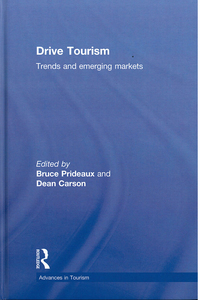What now? Concluding remarks
Carson, Dean, and Prideaux, Bruce (2011) What now? Concluding remarks. In: Prideaux, Bruce, and Carson, Dean, (eds.) Drive Tourism: trends and emerging markets. Advances in Tourism . Routledge, Milton Park, UK, pp. 369-373.
![[img]](https://researchonline.jcu.edu.au/16480/1.hassmallThumbnailVersion/book_cover-Drive_Tourism.jpg)
|
Image (JPEG) (Book Cover)
- Cover Image
Download (1MB) |
|
|
PDF (Published Version)
- Published Version
Restricted to Repository staff only |
Abstract
[Extract] We have previously (Prideaux and Carson 2003) described a framework for research into self-drive tourism markets. The framework was intended to provide a way of organising research into this complex topic. It showed how drive tourism markets are linked to destinations, products, promotion, and physical infrastructure. It proposed that understanding a drive tourism market required investigation of the range of links. In this book we have added a new model (Figure 1.2, page 10) that builds on our original work to illustrate the centrality of the drive experience in the structure and operation of the drive tourism sector. This volume is the third major effort to bring together research into drive tourism following the special issue of the Journal of Vacation Marketing in which the framework was described, and a small book edited by Carson et al. (2002), specifically about the Australian experience. There has clearly been some progress in the field since the Journal of Vacation Marketing special issue. Some of the researchers in that issue have continued to expand their work and are featured here (Hardy, Scott, Carson and Prideaux). New researchers have emerged, particularly outside of Australia, to add a more global view (Cooper, Wang, du Cros, Ong and Lohman). There is evidence of drive tourism being taken up as a central focus in PhD studies (Schmallegger, Cartan and Ali). While it may be argued that drive tourism research remains fragmented, this book represents a collaboration between a range of prominent researchers in the field. Collectively, we have come some way in our understanding of the defining features of drive tourism - it is an independent form of travel that is suited to small groups and 'exploration'-type trips. The modes of travel are numerous, as are the types of destinations and the products that accompany the trip. As the drive market evolves internationally, there is a growing distinction between those who use a self-drive vehicle because it is the cheapest or most easily accessible form of transport, and those who need the vehicle to realise their travel aspirations.
| Item ID: | 16480 |
|---|---|
| Item Type: | Book Chapter (Non-Research) |
| ISBN: | 978-0-415-49149-5 |
| Date Deposited: | 23 Jun 2011 02:55 |
| FoR Codes: | 15 COMMERCE, MANAGEMENT, TOURISM AND SERVICES > 1506 Tourism > 150606 Tourist Behaviour and Visitor Experience @ 100% |
| SEO Codes: | 90 COMMERCIAL SERVICES AND TOURISM > 9003 Tourism > 900399 Tourism not elsewhere classified @ 100% |
| Downloads: |
Total: 178 Last 12 Months: 4 |
| More Statistics |



